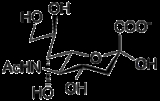
N-Acetylneuraminic acid
Encyclopedia
N-Acetylneuraminic acid (Neu5Ac or NANA) is the predominant sialic acid
found in mammalian cells.
This negatively charged residue is found in complex glycans
on mucin
s and glycoproteins found at the cell membrane
. Neu5Ac residues are also found in glycolipids, such as ganglioside
s, a crucial component of neuronal membranes found in the brain
.
Along with involvement in preventing infections (mucus
associated with mucous membrane
s — mouth, nose, GI, respiratory tract), Neu5Ac acts as a receptor for influenza
viruses, allowing attachment to mucous cells via hemagglutinin
(an early step in acquiring influenzavirus infection).
transporter from Haemophilus influenze and the SatABCD ABC transporter from Haemophilus ducreyi.
Sialic acid
Sialic acid is a generic term for the N- or O-substituted derivatives of neuraminic acid, a monosaccharide with a nine-carbon backbone. It is also the name for the most common member of this group, N-acetylneuraminic acid...
found in mammalian cells.
This negatively charged residue is found in complex glycans
Glycans
The term glycan refers to a polysaccharide or oligosaccharide. Glycans usually consist solely of O-glycosidic linkages of monosaccharides. For example, cellulose is a glycan composed of beta-1,4-linked D-glucose, and chitin is a glycan composed of beta-1,4-linked N-acetyl-D-glucosamine...
on mucin
Mucin
Mucins are a family of high molecular weight, heavily glycosylated proteins produced by epithelial tissues in most metazoans. Mucins' key characteristic is their ability to form gels; therefore they are a key component in most gel-like secretions, serving functions from lubrication to cell...
s and glycoproteins found at the cell membrane
Cell membrane
The cell membrane or plasma membrane is a biological membrane that separates the interior of all cells from the outside environment. The cell membrane is selectively permeable to ions and organic molecules and controls the movement of substances in and out of cells. It basically protects the cell...
. Neu5Ac residues are also found in glycolipids, such as ganglioside
Ganglioside
Ganglioside is a molecule composed of a glycosphingolipid with one or more sialic acids linked on the sugar chain. The 60+ known gangliosides differ mainly in the position and number of NANA residues.It is a component of the cell plasma membrane that modulates cell signal transduction events...
s, a crucial component of neuronal membranes found in the brain
Brain
The brain is the center of the nervous system in all vertebrate and most invertebrate animals—only a few primitive invertebrates such as sponges, jellyfish, sea squirts and starfishes do not have one. It is located in the head, usually close to primary sensory apparatus such as vision, hearing,...
.
Along with involvement in preventing infections (mucus
Mucus
In vertebrates, mucus is a slippery secretion produced by, and covering, mucous membranes. Mucous fluid is typically produced from mucous cells found in mucous glands. Mucous cells secrete products that are rich in glycoproteins and water. Mucous fluid may also originate from mixed glands, which...
associated with mucous membrane
Mucous membrane
The mucous membranes are linings of mostly endodermal origin, covered in epithelium, which are involved in absorption and secretion. They line cavities that are exposed to the external environment and internal organs...
s — mouth, nose, GI, respiratory tract), Neu5Ac acts as a receptor for influenza
Influenza
Influenza, commonly referred to as the flu, is an infectious disease caused by RNA viruses of the family Orthomyxoviridae , that affects birds and mammals...
viruses, allowing attachment to mucous cells via hemagglutinin
Hemagglutinin
Influenza hemagglutinin or haemagglutinin is a type of hemagglutinin found on the surface of the influenza viruses. It is an antigenic glycoprotein. It is responsible for binding the virus to the cell that is being infected...
(an early step in acquiring influenzavirus infection).
Neu5Ac in the biology of bacterial pathogens
Neu5Ac is also important in the biology of a number of pathogenic bacteria as it can used used either as a nutrient, providing both carbon and nitrogen to the bacterium, or in some pathogens, can be activated and placed on the cell surface. Bacteria have evolved transporters for Neu5Ac to enable them to capture it from their environment and a number of these have been characterised including the NanT protein from Escherichia coli, the SiaPQM TRAPTripartite ATP-independent periplasmic transporter
Tripartite ATP-independent periplasmic transporters are a large family of solute transporters found in bacteria and archaea, but not in eukaryotes, that appear to be specific for the uptake of organic acids...
transporter from Haemophilus influenze and the SatABCD ABC transporter from Haemophilus ducreyi.
See also
- Neuraminic acidNeuraminic acidNeuraminic acid is a 9-carbon monosaccharide, a derivative of a ketononose. Neuraminic acid may be visualized as the product of an aldol-condensation product of pyruvic acid and D-mannosamine...
- Sialic acidSialic acidSialic acid is a generic term for the N- or O-substituted derivatives of neuraminic acid, a monosaccharide with a nine-carbon backbone. It is also the name for the most common member of this group, N-acetylneuraminic acid...
- N-Glycolylneuraminic acidN-Glycolylneuraminic acidN-Glycolylneuraminic acid is a sialic acid expressed in apes. It is absent in human tissues because of inactivation of gene encoding CMP-N-acetylneuraminic acid hydroxylase....

